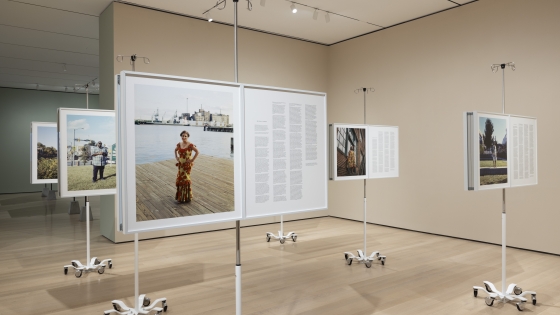Honoring Community Health Workers Through Research and Art
LaToya Ruby Frazier: More Than Conquerors: A Monument for Community Health Workers of Baltimore, Maryland 2021-2022
According to the American Public Health Association, community health workers are frontline public health workers who are trusted members of or have an unusually close understanding of the communities they serve. They are skillful “trust-builders” and experts in navigating health and social services. These qualities enable them to link people with various needs to resources that support their well-being. “More Than Conquerors” celebrates their essential contributions in support of people who experience social marginalization. Funded in part by a National Geographic Storytelling Fellowship, Frazier’s exhibit was commissioned for the 58th Carnegie International in 2022, where it won the Carnegie Prize. It was acquired by the Baltimore Museum of Art in 2023.
Powerful and evocative, the installation monumentalizes the community health workers’ vital efforts and challenges us to consider the nature of how and who we honor.
Join us on November 21, 2024, at 6 pm at the Baltimore Museum of Art for a free panel discussion that speaks to the role of community-engaged research in the new exhibition LaToya Ruby Frazier: More Than Conquerors: A Monument for Community Health Workers of Baltimore, Maryland 2021-2022.
Hear from local community health workers Madelin Martinez, MPH, Wilfredo (Wil) Torriente, and Latish Walker in a conversation presented by Lisa Cooper, MD, MPH, Bloomberg Distinguished Professor and Founding Director, Johns Hopkins Center for Health Equity, and moderated by Chidinma Ibe, PhD, Assistant Professor and Associate Director of Community Engagement, Johns Hopkins Center for Health Equity.
Register at the first link below.

More Than Conquerors: Where Research and Art Meet
Frazier’s photographic installation focuses on the Baltimore community health workers with whom she connected through Johns Hopkins Center for Health Equity researchers, Drs. Lisa Cooper and Chidinma Ibe. Cooper and Frazier first connected during a 2015 conversation hosted by The Contemporary and the Baltimore School for the Arts that explored how the powers of art, medicine, politics, science, and technology might intersect to address environmental racism. That meeting highlighted their shared interests in uplifting the voices of people who experience social marginalization, using approaches informed by their unique professional and lived experiences. One of these tools includes photovoice, a community-based participatory research method used by Cooper’s Johns Hopkins team and their community partners. Photovoice elevates the voices and experiences of those from socially disenfranchised communities in ways that move beyond traditional research. People participating in photovoice studies take pictures of their local communities and discuss the images as a group. Together, they explore their community’s needs, strengths, and capacity for social change. Cooper recognized similarities to the photovoice concept in Frazier’s earlier series The Notion of Family, identifying it as medical photography.
Cooper and Frazier met again at a 2018 MacArthur Foundation Fellows Forum, where a cohort of scientists, doctors, scholars, filmmakers, and photographers convened to explore collaborations. This prompted their thinking about what they could achieve together around social justice and health inequities. During the COVID-19 pandemic, Frazier was awarded a National Geographic Storytelling Fellowship, which provided resources that helped to support their collaboration. The two friends, along with colleagues and community health workers in Baltimore, went on to build the foundations of this exhibition.

A Community Lens on Health
Led by Dr. Chidinma Ibe, the Amplifying the Lived Experiences of Community Health Workers (ALEC) Study used photovoice to shed light on CHWs’ personal and professional experiences. Photovoice is a participatory research method – meaning that study participants partner with study investigators to shape how the research project unfolds. In Photovoice, study participants take pictures of their local environments and discuss the images as a group. These pictures and conversations enable the group to explore communities’ needs, strengths, and capacity for social change from the study participants’ perspectives. By combining images with stories, Photovoice is a powerful tool that can deepen people’s understanding of the factors that affect social conditions. This allows them to develop potential solutions to address complex social challenges.

The Unsung Heroes of Community Wellness
Community health workers (CHWs) are vital to reducing health disparities and promoting health equity. Since they are usually members of the communities they support, they have a unique understanding of what it takes to help people from their communities access the resources that support their overall well-being. They are change agents, identifying people’s health-related needs, offering social support, promoting healthy behaviors, and advocating for individuals, families, and communities. CHWs are typically employed by community-based organizations, healthcare delivery systems, or public health agencies. Regardless of where they are based, CHWs eliminate barriers to receiving quality health care and contribute to disease prevention efforts. Their efforts make them natural bridges between patients and healthcare and social service professionals, enabling organizations to be more responsive to the needs of people seeking their services.

